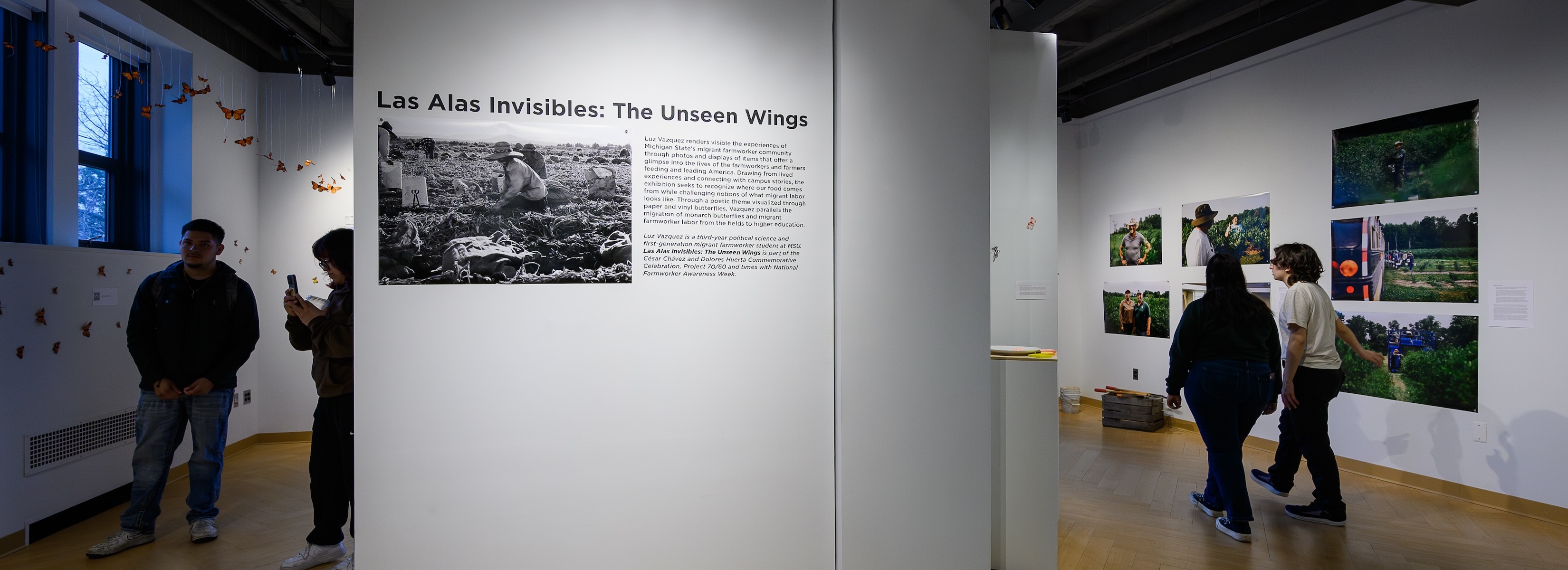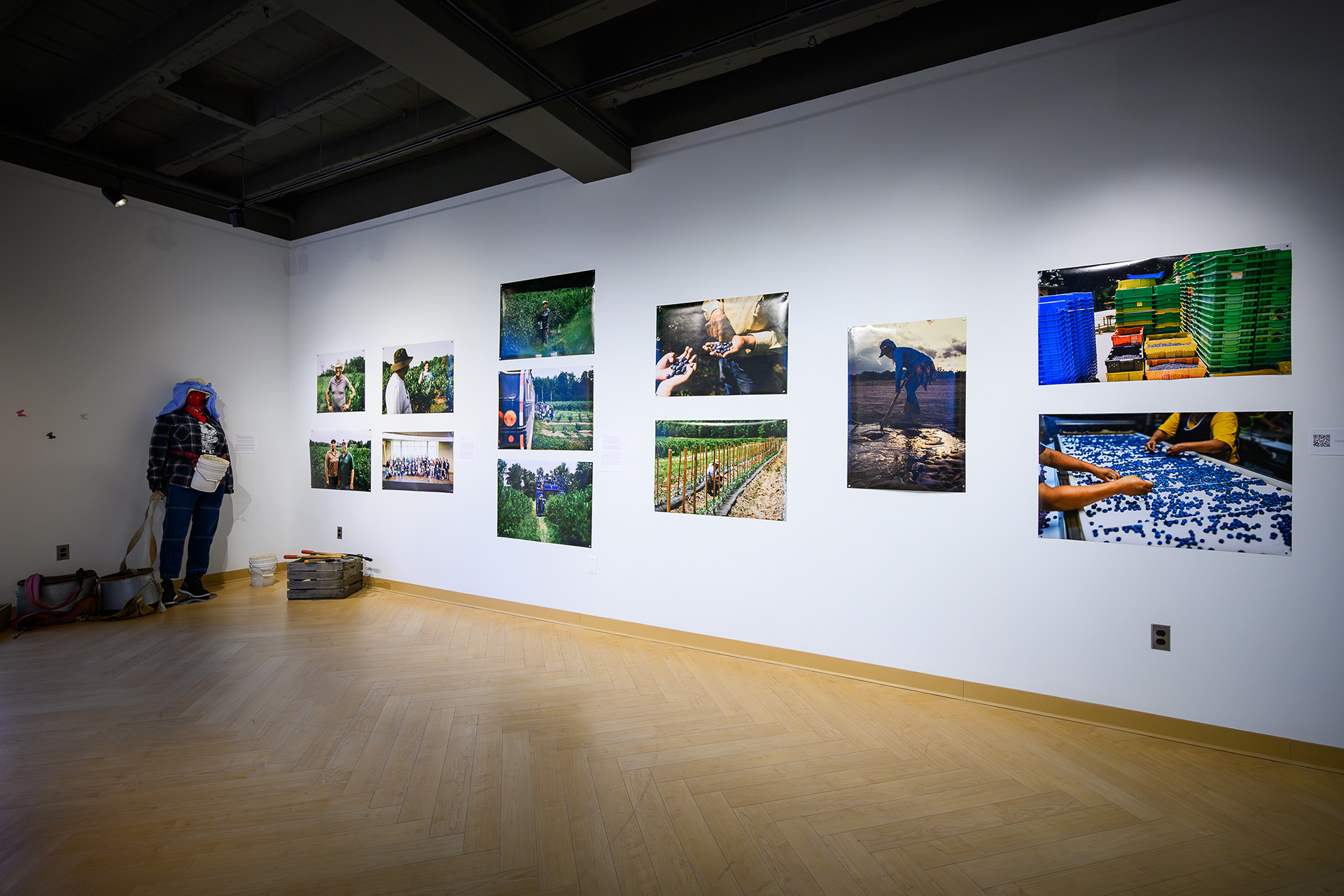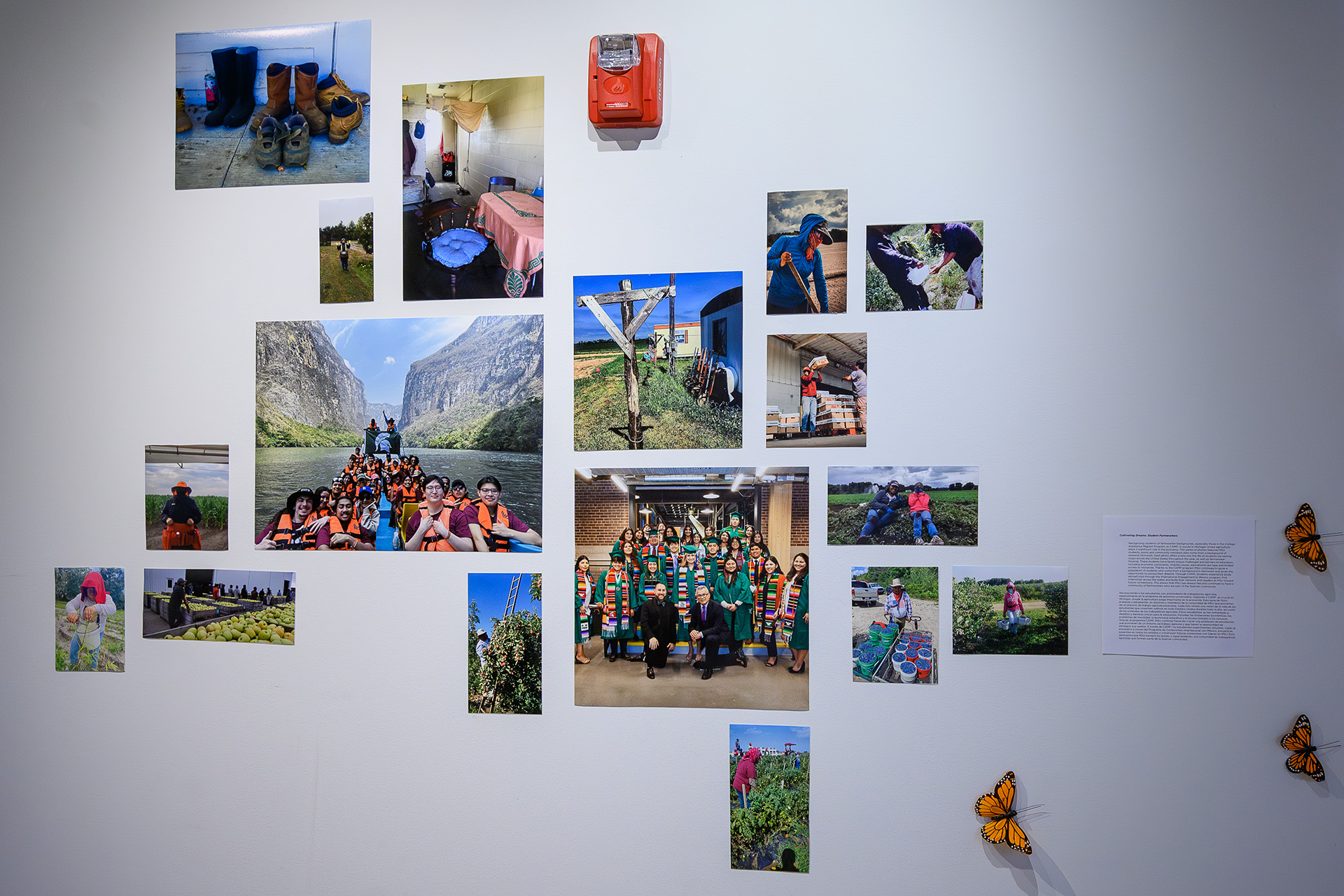The Las Alas Invisibles: The Unseen Wings exhibition at Michigan State University is the culmination of a yearlong campaign to raise awareness and visibility of MSU’s migrant farmworker community. The exhibition is part of the César Chávez and Dolores Huerta Commemorative Celebration and Project 70/60, and coincides with National Farmworker Awareness Week.

“If you ate today, thank a farmworker,” reads a small sign in the MSU Union Art Gallery. Surrounding this sign are many others like it, paired with pieces of art that tell the story of migrant farmworkers and their importance in Michigan.
These are part of the new art exhibition “Las Alas Invisibles: The Unseen Wings,” on view from March 18 to 30 at the MSU Union. Luz Vazquez, a third-year political science major and first-generation migrant farmworker student, collaborated with peers to create the exhibition to honor and recognize the migrant farmworker community at MSU for National Farmworker Awareness Week.
Vazquez currently studies political science and public policy in the College of Social Science and brings a dedication to advocating for migrant farmworker awareness, as she grew up in the community. She identified an opportunity to honor farmworkers and took it upon herself to explore how to share these important stories in an exhibition.
“With my background experience and knowledge in farm work, I wanted this exhibit to show who farmworkers are authentically by giving a glimpse into their lives,” said Vazquez. “I often read stories on farmworkers featuring their photos, yet there is so much more that people don’t see or understand. Farmworkers remain unrecognized and invisible when they shouldn’t be because they provide our three meals.”

This realization led Vazquez to the exhibition’s theme, which centered around the migration of butterflies. Throughout the exhibition, viewers will see butterflies hanging from the ceiling and on the walls, paralleling the northern migration of monarch butterflies and seasonal farmworker labor to Michigan.
“This exhibition’s name, ‘Las Alas Invisibles: The Unseen Wings,’ says it all,” said Elias Lopez, senior associate director of the College Assistance Migrant Program, or CAMP. “Farmworkers are the engine of agriculture and often go unrecognized for their contribution. There is no question that farmworkers feed America. [The exhibition] provides a window to farmworkers and their sacrifices for all of us.”
To kick off the exhibition's opening, a reception was held on March 18 in the MSU Union Art Gallery. The event was hosted by Karina Hernandez, a fourth-year student in the College of Social Science, and allowed guests to enjoy food, walk through the exhibition and hear from speakers, including Vazquez, on the exhibition's importance.

Migrant Student Services Director Luis Alonzo Garcia, Interim Provost Thomas Jeitschko, MSU Extension Director Quentin Tyler and College Assistance Migrant Program Senior Associate Director Elias Lopez all gave remarks at the reception. Each expressed gratitude for migrant farmworkers, admiration for their work and the need for more representation.
Garcia, a long-time migrant student advocate, started the remarks by drawing attention to the agency and power of migrant student voices in shaping the university.
To the question, “Do you think the university listens to and understands your challenges, hopes, dreams and contributions?” migrant farmworker students replied, "It’s clear they get their information from interpreters; we don’t need interpreters; we can speak for ourselves; just ask us,” shared Garcia.
The exhibition features photography, video and other materials contributed by Vazquez’s peers and includes the following sections:

Addressing invisibility
A collection of large, printed photos hangs on a wall in the art gallery. These photos provide a window into the lives and work of Latino/a farmers and farmworkers in West Michigan blueberry farms.
Michigan thrives in agriculture, but the hands that make this agriculture possible have been invisible. Despite being forgotten, they are still essential to the nation and agriculture industry to ensure food security. The workers in these farms, including those in these photos, typically labor in demanding conditions and face challenges that make the job difficult. These prints provide insight into these conditions and hands at work.

Protective clothing
Immediately next to the collection of photos stands a mannequin wearing clothing that a typical farmworker would wear. This clothing provides protection, comfort and functionality for agricultural work. While the attire might vary based on the type of farm work and workers’ preferences, it usually includes many layers of protection. In some cases, women cover their faces and bodies to ward off unwanted attention.
Different tools are displayed around the mannequin, who carries a blueberry bucket on her waist. Farmworkers use various tools in their daily work depending on the type of agriculture that helps them complete their duties, including the apple sacks and pruning shears on display.

If you ate today, thank a farm worker
A pedestal with a small plate filled with sticky notes sits in a corner of the gallery. On each of these notes, visitors viewing the exhibition have written down their own thank-you letters to farm workers and their contributions to society. The display reminds people that if they had food on their plates today, it came from the hands of migrant farmworkers. The piece emphasizes the invisibility that exists while simultaneously drawing attention to how essential migrant labor is to the livelihood of America. Visitors are encouraged to write thank-you notes creatively, letting farmworkers know their work is appreciated.

Cultivating dreams: Student farmworkers
On another large wall in the gallery hangs another collection of printed photographs. This series of photos features MSU students, alums and community members who come from a background of seasonal farm work. The photos provide a window into the lives of those harvesting crops in the United States as well as their housing. The students face unique challenges when it comes to their education. Barriers that create these difficulties include economic constraints, mobility issues, educational red tape and limited access to resources. The CAMP program at MSU aims to tackle these barriers and grow a population of students from a background of farm work to allow them to pursue their dreams.

Throughout the exhibition, QR codes are displayed, linking to migrant farmworker stories from recognizing the successes of MSU’s bilingual agriculture program supporting first-generation Latino/a farmers to graduates like Dayana Villagran, who went from climbing a ladder to pick apples every day to breaking barriers as a woman mechanical engineer at General Motors. These and other stories are placed around the exhibition on butterfly-adorned walls.

Snap and pin
Another interactive element of the exhibition is a map, where people can pin a photo or sticker onto a map of Michigan to show where crops are from. On the wall opposite the map lies a large decal butterfly with an instant camera, where people can take their own photos to pin to the map. The connection between butterflies and migrant farmworkers lies in the cyclical nature of their migration. Both farmers and butterflies migrate, and their migration involves resilience and adaptation.
“Las Alas Invisibles: The Unseen Wings” is open from March 18 to 30 at the MSU Union Art Gallery, 2nd Floor. Visitors can look forward to picking up five specialty print postcards featuring a selection of photos from the exhibition to help share the message of migrant farmworker appreciation and awareness.
Photo credit: Dane Robison